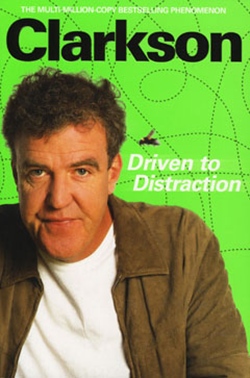One of the latest books from Jeremy Clarkson is entitled Driven to Distraction (ISBN 978-0-141-04420-0, Penguin Group, 2010) and follows the same basic format as his others “The World According to Clarkson”, “I know you got Soul” and “For Crying Out Loud”, where he has collated his weekly columns from the British Sunday Times and Penguin has published it in soft cover.
Jeremy Clarkson is very well known to most petrol-heads as the anchorman for the very successful TV series “Top Gear”, which although it has cars and sundry assorted vehicles as the subject matter, it is not technically based and the format is such as to entertain, rather than educate.

This format Clarkson uses in his weekly Sunday Times columns as well. There will be, eventually, some description of a test vehicle, and Clarkson’s opinion of it. In many instances, the punchline comes right at the end, such as his report on the Audi TT, “I shall stop short of saying I loved the new TT. You cannot love something that looks so similar to something you loathed. But I did enjoy driving it.” Damned with faint praise, a technique Clarkson uses many times.
However, sometimes there is a brutality, such as for the Mercedes R Class where he writes in the final two sentences, “This, contrary to my earlier reports, is not an estate, it is a 4×4. And not a very good one. You’re better off buying a condom.”
His attack on the Mini Cooper S Clubman is straight to the point, “Unfortunately after a week, I have decided it’s one of the worst cars in the world. About as desirable as a packet of dung or a can of worms. Truthfully? I’d rather have a goat.”
He has a healthy disregard for the modern lifestyle dictated by being PC and describes an English traffic jam as “… the road was chockablock. More crammed than a public bog in Algiers the day after Ramadan.”
As opposed to columns with cars as excuses for their being, this book has what is called a Part 2, which has no cars, but are forums for Clarkson to wax eloquent on subjects as diverse as President Bush, the Russian situation and Red Square, and space travel. His style is in a similar genre to Bill Bryson where hyperbole is used for comedic effect “… the tyres were made of plywood.” It is this Part 2 that you can see that Clarkson is a very funny man, and does not need motor cars to be entertaining.
With 58 chapters (albeit short chapters) it is a thick book at 466 pages, but the format is such that you can pick up and put down at will. It is not the kind of book you settle into for a weekend.
Because his weekly column is in a British newspaper, there are many references to people of note in the UK. Some of these are not known to the wider global audience (or to me) but this did not impinge upon the enjoyment of this book. At B. 425 it is a cheap chuckle.




